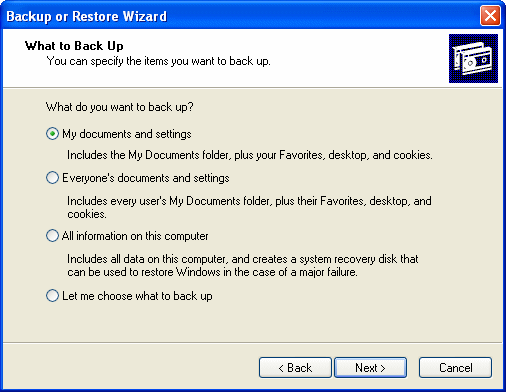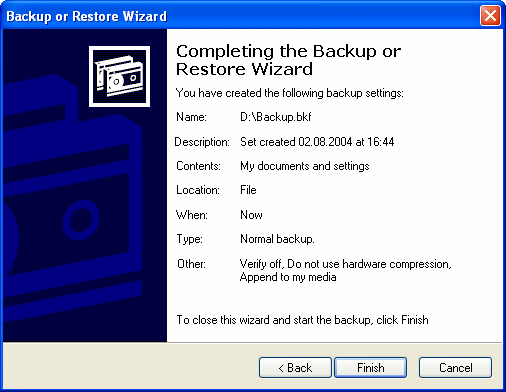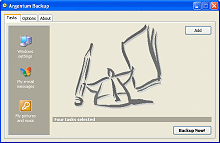Backup Articles
How to use Windows Backup
Getting Started
Fortunately, backing up your essential files is neither difficult nor time-consuming. In fact, the whole process can take as little as 10 minutes a week, and you can let Windows XP do most of the work. Before you can even think about creating a backup, you have to get your files in order. Just check to make certain all your essential data files are stored in one easy-to-find location.
Windows XP makes this task especially easy by giving every user account its own personal profile, which consists of a set of subfolders in the Documents and Settings folder. Your profile holds your personal files (the My Documents folder), Outlook Express e-mail messages, Internet Explorer Favorites and cookies, and information about your settings and preferences. If you have personal data stored elsewhere, consider moving it into the My Documents folder to make backing up easier. If you're unwilling or unable to move those files, make a note of where they're located so you can be sure you add them to your backup set later.
Open Windows XP Backup
Windows XP includes its own backup program, although you may need to do some digging to find it. You can also take your pick of third-party program (listed at the end of this article) that add bells and whistles you won't find in the basic Windows XP Backup utility.
The Windows Backup utility is not included in the default installation of Windows XP Home Edition. The Backup icon is not on the Start menu in Windows XP Home, nor is Backup listed in Add/Remove Programs for Windows XP Home. The program is included on the CD-ROM in the Valueadd folder. To use the program, you have to install it manually. To manually install Backup double-click the Ntbackup.msi file in the following location on the Windows XP Home Edition CD-ROM to start a wizard that installs Backup: \VALUEADD\MSFT\NTBACKUP. When the wizard is complete, click Finish, and you're done.
You're now ready to begin backing up. By default, the Backup utility uses a wizard that makes the process straightforward. To start Backup:
- Click Start, point to All Programs, point to Accessories, point to System Tools, and then click Backup to start the wizard.
- Click Next to skip past the opening page, choose Back up files and settings from the second page, and then click Next.

Decide what to back up
- You might be tempted to click All information on this computer so that you can back up every bit of data on your computer. Think twice before choosing this option, however. If you've installed a lot of software, your backup could add up to many gigabytes. For most people, the My documents and settings option is a better choice. This selection preserves your data files (including e-mail messages and address books) and the personal settings stored in the Windows Registry.
- If several people use your computer - as might be the case on a shared family PC - select Everyone's documents and settings. This option backs up personal files and preferences for every user with an account on the computer.
- If you know that you have data files stored outside your profile, click Let me choose what to back up. This option takes you to the Items to Back Up page. Select the My Documents check box to back up all the files in your personal profile, and then browse the My Computer hierarchy to select the additional files you need to back up. If some of your files are on a shared network drive, open the My Network Places folder and select those folders. This option also comes in handy if you have some files you don't want to back up. For instance, if you have more than 10 GB of music files in the My Music folder, to keep your data file backup to a reasonable size, click the check box next to the My Music folder. This clears the check box from all the files and subfolders in My Music.
Decide where to store your backup copy
On the Backup Type, Destination, and Name page, Windows asks you to specify a backup location. If you're one of those rare individuals with access to a backup tape, the Backup utility gives you a choice of options in the Select a backup type box. No tape drive? No problem. Backup assumes you're going to save everything in a single file - you just have to choose a location for that file and give it a name.
By default, Backup proposes saving everything to your floppy drive (drive A:). Although that might have made sense 10 years ago, it's hardly a rational choice today. You'd need dozens, perhaps hundreds of floppy disks to store even a modest collection of data files, especially if you collect digital music or photos.
- Your computer's hard disk. The ideal backup location is a separate partition from the one you're backing up. If your hard disk is partitioned into drive C: and drive D: and your data is on drive C:, you can safely back up to drive D:.
- A Zip drive or other removable media. At 100-250 MB per disk, this is an option if you don't have multiple gigabytes to back up. Unfortunately, the Windows Backup utility can't save files directly to a CD-RW drive.
- A shared network drive. You're limited only by the amount of free space on the network share.
- An external hard disk drive. USB, USB 2, and IEEE 1394 or FireWire drives have dropped in price lately. Consider getting a 120 GB or larger drive and dedicating it for use as a backup device.
- A flash memory USB stick (key).
After you've chosen a backup location, enter a descriptive name for the file, click Next to display the wizard's final page, and then click Finish to begin backing up.

Set a schedule for backup
If you're disciplined enough, you can repeat the above steps once each week and perform regular backups when you're ready. If you'd rather not count on remembering to perform this crucial task, however, set up an automatic backup schedule for Windows. When you get to the final page of the Backup Wizard, don't click Finish. Instead, click the Advanced button, and click Next to open the When to Back Up page. Choose Later, and then click Set Schedule to open the Schedule Job dialog box.
A weekly backup on Friday afternoon is a good way to make sure your week's work is protected. But you can set almost any schedule you want by poking around in the extensive set of options available in this dialog box. After you click OK to save your changes, Windows XP runs the backup automatically. Just remember to leave your computer turned on.
All in all, you can count on backing up 5 GB of data in as little as 10 minutes. And you don't need to worry about shutting down running programs, either - thanks to a feature called volume shadow copy, the Backup utility can safely create a copy of any file, even if it's currently in use.
Backup alternatives
The Windows Backup utility is handy and free, but it's not your only backup choice. Depending on your preferences, you can choose all sorts of third-party backup solutions. Naturally, you always have the option of copying important files to removable media. With DVD-RW drives and their 4700 MB-per-disk capacity, that's an attractive option. In fact, just about any backup program is preferable to doing nothing and hoping that your data will magically take care of itself.
 Argentum™ Backup
Argentum™ Backup
PC Magazine Editors' Choice
PC World Best Buy
- What is Argentum Backup? Argentum Backup is an alternative backup solution, which is available for free online download! Download your copy now and see if it works for you! Argentum Backup is a handy, small backup program that lets you back up your documents and folders quickly and much easier! Argentum Backup safely protects you from accidental deletes, overwrites, viruses, and computer failures. Argentum Backup is fast and very easy to use.
- Argentum Backup includes a number of built-in, patented templates to back up Windows registry, Windows desktop settings, Outlook folders, e-mail messages and address book, database of your favorite messenger: ICQ, MSN, Yahoo!, and AOL. The program is fully compatible with all of the currently available Microsoft Windows systems: 95, 98, ME, NT, 2000, Server, XP, Vista, 7, 8, and 10.
- Argentum Backup is suitable for both beginners and advanced users. Advanced features include powerful stacking, file masks, adjustable backup store, native file copying mode, different backup strategies and more. You can store backups in regular Zip files and create them both manually and automatically, using the schedule. Argentum Backup was designed around and built for end users. A key design goal for the product was to ensure that users spend their time accomplishing their objectives, rather than worrying about or having to manage their backup software.
|
|
Summary
- Most intuitive backup software ever. Extremely user-friendly and very easy to use.
- Extremely compact, fast and reliable.
- Simply creates Zip (or Zip64) files.
- Back up specific file locations on any Windows 95, 98, 2000, XP, Vista, 7, 8 and 10, fully automatically, with a rich set of built-in backup templates.
- Argentum Backup is cheap but good. $39 only if you use this opportunity today!
More
[ To the top ]
Copyright © 1995 - 2024 Argentum Corporation. Terms of use.



